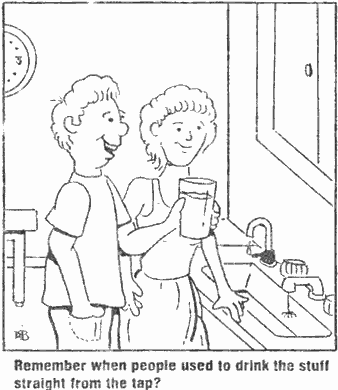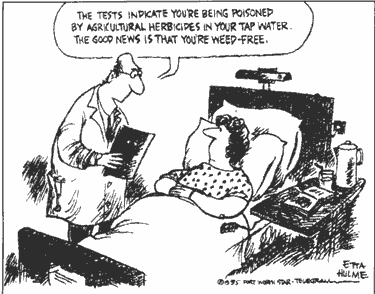The New York Times’ Great Water Article
by Hardly Waite
Back in 1992 when the paper Pure Water Gazette printed an entire issue called “The Gazette’s Great Water Article,” magazine stories about the condition of  US waters were common. Unfortunately, though magazines and newspapers keep grinding out articles that point out the same old shortcomings of the way the US cares for its most precious resource, nothing of significance has been done to change things since the Clean Water Act of the 1970s.
US waters were common. Unfortunately, though magazines and newspapers keep grinding out articles that point out the same old shortcomings of the way the US cares for its most precious resource, nothing of significance has been done to change things since the Clean Water Act of the 1970s.
I regret to say it isn’t likely that things will change.
There is simply no political will to address the serious problems facing the nation’s water supplies, and there are rich and powerful vested interests who beat down every attempt at reform.
Here are a few examples of the problems.
There are now, by the EPA’s estimate, some 60,000 chemicals being used in the United States. The EPA, the regulatory agency which was created under the Clean Water Act to look after our water supplies, has regulatory standards for only 91 of these. The remaining 59,900 or so are not being monitored by your water supplier.
Attempts to broaden regulation are met immediately with crushing opposition from wealthy opponents in industry or even our own government. This is because our government is now populated by people who worked in the for-profit sector last year or will work there next year. It’s called a revolving door.
States oppose regulations that would affect businesses, although the health of their citizens is at stake.
Every attempt to regulate use of the powerful water contaminant perchlorate, a rocket fuel ingredient, has been fought by the mighty propaganda machine of the US military. Military propagandists, with public financing, publicly question the patriotism of proponents of perchlorate regulation. If you love your country, you’ll drink your rocket fuel and keep your mouth shut.
The regulatory standards for the tiny number of contaminants the EPA has acted upon are pitifully inadequate, and enforcement is lax. And the standards themselves are of very questionable accuracy.
The truth is that no one really knows how much vinyl chloride or benzene one can safely ingest over a period of years. Contrary to the mythology promoted by regulating agencies and water suppliers, the EPA’s magic numbers aren’t based on some concrete and absolute scientific standard that deserves our confidence. EPA standards are politically negotiated numbers–backroom compromises that set the standard somewhere between an assumed safe level and what is convenient for the polluting industry or the water supplier. Even the “science” used by regulators to determine safe levels is laughable; it is still based, now, in the 21st century, largely on “animal studies,” a branch of science that would have died in the Middle Ages if it were not so profitable and useful to manipulators.
Similarly, few Americans seem aware of the deplorable state of the aging infrastructure that handles our water and sanitation systems. The original Clean Water Act provided at least limited funds for the rebuilding of the nation’s water and sanitation systems. Since that time, although Congress has found ample funds for endless wars, bank bailouts, and tax relief for the super rich, there is never any money for such unglamorous items as the expansion and repair of sewage systems that were designed for half the population that we now have. In most urban areas today, even a 1/2″ rain shower overwhelms the drainage system and pours thousands of gallons of untreated sewage and chemical runoff into drinking water reservoirs.
These and many other aspects of the highly inadequate management of our water resources are discussed at length in an exceptional multi-article study that appeared over a period of months in the New York Times. These well-documented pieces include information that cause one to think twice before trusting the water that comes straight from the tap. From the Times’ studies one learns, for example, that since 2004 “the water provided to more than 49 million people has contained illegal concentrations of chemicals like arsenic or radioactive substances like uranium, as well as dangerous bacteria often found in sewage.” The Timesconfirms the finding of previous Associated Press studies that one in six Americans is ingesting pharmaceuticals in their drinking water.
Most discouraging of all is the finding that there have been more than half a million violations of the Clean Water Act committed by water suppliers since 2004 and only 6 percent of the water systems that broke the law were ever fined or in any way punished by state and federal officials. And fines to wealthy polluters are usually just a slap on the wrist–the amount being a tiny part of what the polluter saved by ignoring the law.
A substantial portion of the Times reports can be found here:
•http://www.nytimes.com/2009/12/17/us/17water.html?_r=2&th&emc=th
• http://www.nytimes.com/2009/12/08/business/energy-environment/08water.html?_r=1&sudsredirect=true
• http://projects.nytimes.com/toxic-waters
I hope you’ll read them. There’s a wealth of information, and especially several video reports worth watching. Watch the videos. You’ll like them.
Source: Pure Water Occasional.




